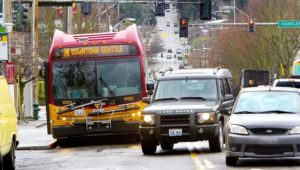Everyone has seen a bus signaling that they are re-entering traffic but what are the rules? Do they have special rights that other cars do not because they are a bus? Some bus drivers will force their way into traffic making close calls with drivers making it seem like they believe they have the right of way over cars behind them. Do they?
 Actually, buses do have more rights than other cars. When a bus signals it is re-entering the flow of traffic from a stop, the drivers behind the bus going the same direction must yield to the bus re-entering traffic. This does not mean that a bus has the right of way to move over into your lane of travel and move wherever they want. This code applies to re-entering the flow of traffic not moving around the flow of traffic.
Actually, buses do have more rights than other cars. When a bus signals it is re-entering the flow of traffic from a stop, the drivers behind the bus going the same direction must yield to the bus re-entering traffic. This does not mean that a bus has the right of way to move over into your lane of travel and move wherever they want. This code applies to re-entering the flow of traffic not moving around the flow of traffic.Why give buses the right of way? The law was written to allow buses to move around faster. It is hard for a bus to stop and then re-enter traffic if traffic is congested and no one is letting them merge back in. Buses are large and carry a large amount of people so they may not be able to see every car around them. Also, they are seen as 20-40 people on the bus that would represent 20-40 cars had they not taken the bus so that saves travel time for others in cars and alleve traffic congestion.
Who is at fault if a bus merges quickly with no warning or time for other drivers to yield? Buses may not force themselves into traffic if another car could not avoid them. The bus would be at fault for merging into a car if the car could not have yielded to the bus. This could be the case where a bus signals and merges at the same time without giving time for others to recognize the bus is signaling and causes a car accident. The bus driver and city of Seattle would be liable for any resulting injuries due to the bus driver’s negligence.
What is the penalty for failing to let a bus in? Seattle traffic tickets are issued at $124 for drivers who fail to yield the right of way to a bus re-entering the flow of traffic from a stop. Additionally, the driver of the car would be at fault if they caused a car accident if they failed to yield the right of way to a bus re-entering traffic. However, the bus may be seen at fault if the bus driver did not give enough warning to the driver, causing the car accident injury case.
The Law:
A. The driver of a vehicle shall yield the right-of-way to a transit vehicle traveling in the same direction that has signalled and is re-entering the traffic flow.
B. This section shall not operate to relieve the driver of a transit vehicle from the duty to drive with due regard for the safety of all persons using the street or alley.
C. For purposes of this section, “transit vehicle” means a motor vehicle, street car, train, or trolley which is owned or operated by a city, county, county transportation authority, a public benefit area, or the state, and which is used to carry passengers on a regular schedule. (RCW 46.04.355; 69.50.435(5), (6)).
